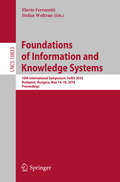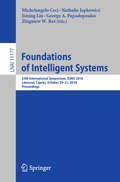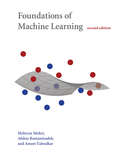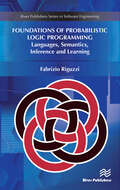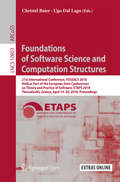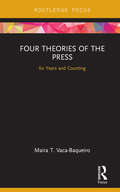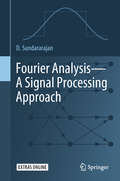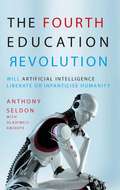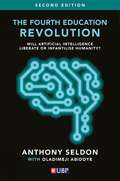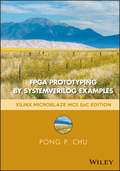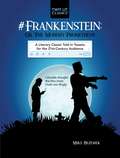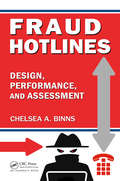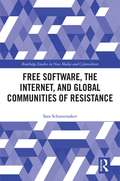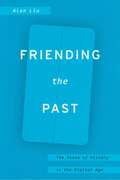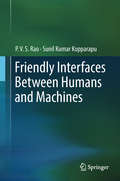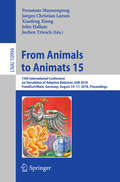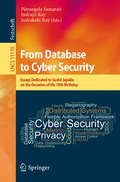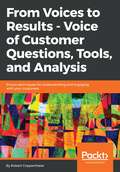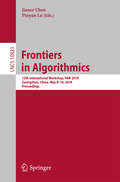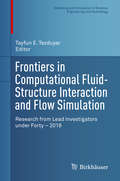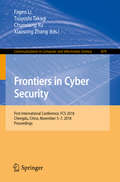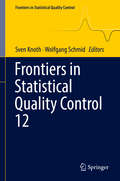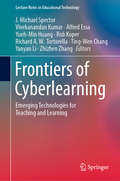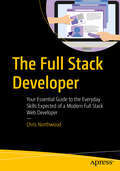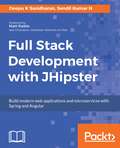- Table View
- List View
Foundations of Information and Knowledge Systems: 10th International Symposium, Foiks 2018, Budapest, Hungary, May 14-18, 2018, Proceedings (Lecture Notes in Computer Science #10833)
by Flavio Ferrarotti Stefan WoltranThis book constitutes the refereed proceedings of the 10th International Symposium on Foundations of Information and Knowledge Systems, FoIKS 2018, held in Budapest, Hungary, in May 2018.The 20 revised full papers presented together with 1 invited talk were carefully reviewed and selected from 40 submissions. The papers address various topics such as big data; database design; dynamics of information; information fusion; integrity and constraint management; intelligent agents; knowledge discovery and information retrieval; knowledge representation, reasoning and planning; logics in databases and AI; mathematical foundations; security in information and knowledge systems; semi-structured data and XML; social computing; the semantic web and knowledge management; and the world wide web.
Foundations of Intelligent Systems: 24th International Symposium, ISMIS 2018, Limassol, Cyprus, October 29–31, 2018, Proceedings (Lecture Notes in Computer Science #11177)
by Michelangelo Ceci Nathalie Japkowicz Jiming Liu George A. Papadopoulos Zbigniew W. RaśThis book constitutes the proceedings of the 24th International Symposium on Foundations of Intelligent Systems, ISMIS 2018, held in Limassol, Cyprus, in October 2018. The 32 full, 8 short, and 4 application papers presented in this volume were carefully reviewed and selected from 59 submissions. The papers deal with topics such as bioinformatics and health informatics, graph mining, image analysis, intelligent systems, mining complex patterns, novelty detection and class imbalance, social data analysis, spatio-temporal analysis, and topic modeling and opinion mining. In addition, three special sessions were organized, namely: Special Session on Granular and Soft Clustering for Data Science, Special Session on Intelligent Methodologies for Traffic Data Analysis and Mining, and Special Session on Advanced Methods in Machine Learning for Modeling Complex Data.
Foundations of Machine Learning (Adaptive Computation and Machine Learning)
by Mehryar Mohri Afshin Rostamizadeh Ameet TalwalkarA new edition of a graduate-level machine learning textbook that focuses on the analysis and theory of algorithms.This book is a general introduction to machine learning that can serve as a textbook for graduate students and a reference for researchers. It covers fundamental modern topics in machine learning while providing the theoretical basis and conceptual tools needed for the discussion and justification of algorithms. It also describes several key aspects of the application of these algorithms. The authors aim to present novel theoretical tools and concepts while giving concise proofs even for relatively advanced topics. Foundations of Machine Learning is unique in its focus on the analysis and theory of algorithms. The first four chapters lay the theoretical foundation for what follows; subsequent chapters are mostly self-contained. Topics covered include the Probably Approximately Correct (PAC) learning framework; generalization bounds based on Rademacher complexity and VC-dimension; Support Vector Machines (SVMs); kernel methods; boosting; on-line learning; multi-class classification; ranking; regression; algorithmic stability; dimensionality reduction; learning automata and languages; and reinforcement learning. Each chapter ends with a set of exercises. Appendixes provide additional material including concise probability review. This second edition offers three new chapters, on model selection, maximum entropy models, and conditional entropy models. New material in the appendixes includes a major section on Fenchel duality, expanded coverage of concentration inequalities, and an entirely new entry on information theory. More than half of the exercises are new to this edition.
Foundations of Probabilistic Logic Programming: Languages, Semantics, Inference and Learning
by Fabrizio RiguzziProbabilistic Logic Programming extends Logic Programming by enabling the representation of uncertain information by means of probability theory. Probabilistic Logic Programming is at the intersection of two wider research fields: the integration of logic and probability and Probabilistic Programming.Logic enables the representation of complex relations among entities while probability theory is useful for model uncertainty over attributes and relations. Combining the two is a very active field of study.Probabilistic Programming extends programming languages with probabilistic primitives that can be used to write complex probabilistic models. Algorithms for the inference and learning tasks are then provided automatically by the system.Probabilistic Logic programming is at the same time a logic language, with its knowledge representation capabilities, and a Turing complete language, with its computation capabilities, thus providing the best of both worlds.Since its birth, the field of Probabilistic Logic Programming has seen a steady increase of activity, with many proposals for languages and algorithms for inference and learning. Foundations of Probabilistic Logic Programming aims at providing an overview of the field with a special emphasis on languages under the Distribution Semantics, one of the most influential approaches. The book presents the main ideas for semantics, inference, and learning and highlights connections between the methods.Many examples of the book include a link to a page of the web application http://cplint.eu where the code can be run online.
Foundations of Software Science and Computation Structures: 21st International Conference, Fossacs 2018, Held As Part Of The European Joint Conferences On Theory And Practice Of Software, Etaps 2018, Thessaloniki, Greece, April 14-20, 2018. Proceedings (Lecture Notes in Computer Science #10803)
by Christel Baier Ugo Dal LagoThis book constitutes the proceedings of the 21st International Conference on Foundations of Software Science and Computational Structures, FOSSACS 2018, which took place in Thessaloniki, Greece, in April 2018, held as part of the European Joint Conference on Theory and Practice of Software, ETAPS 2018.The 31 papers presented in this volume were carefully reviewed and selected from 103 submissions. The papers are organized in topical sections named: semantics; linearity; concurrency; lambda-calculi and types; category theory and quantum control; quantitative models; logics and equational theories; and graphs and automata.
Four Theories of the Press: 60 Years and Counting
by Maira T. Vaca-BaqueiroThe links between distinctive political regimes and media systems are undeniable. As Siebert, Peterson and Schramm wrote (1956: 1) 60 years ago: ‘the press always takes on the form and coloration of the social and political structures within which it operates’. Nevertheless, today’s world and politics are completely different from the bipolar era that inspired the ground breaking Four Theories of the Press. What are the main changes and continuities that have driven the study of politics and the media in the last decades? How to approach this interaction in the light of the challenges that democracy is facing or the continuing technological revolution that at times hampers the media?This provocative book explores the main premises that have guided the study of politics and the media in the last decades. In so doing, it gives the reader key analytical tools to question the sustainability of past categorizations that no longer match up with current developments of both, political regimes and the media. In searching for clarification about current discrepancies between democracies and media’s distinctive structures or purposes, Four Theories of the Press: 60 Years and Counting puts forward an alternative premise: the political-media complex.
Fourier Analysis—A Signal Processing Approach
by D. SundararajanThis book sheds new light on Transform methods, which dominate the study of linear time-invariant systems in all areas of science and engineering, such as circuit theory, signal/image processing, communications, controls, vibration analysis, remote sensing, biomedical systems, optics and acoustics. It presents Fourier analysis primarily using physical explanations with waveforms and/or examples, only using mathematical formulations to the extent necessary for its practical use. Intended as a textbook for senior undergraduates and graduate level Fourier analysis courses in engineering and science departments, and as a supplementary textbook for a variety of application courses in science and engineering, the book is also a valuable reference for anyone – student or professional – specializing in practical applications of Fourier analysis. The prerequisite for reading this book is a sound understanding of calculus, linear algebra, signals and systems, and programming at the undergraduate level.
The Fourth Education Revolution
by Anthony Seldon Oladimeji AbidoyeThere is no more important issue facing education, or humanity at large, than the fast approaching revolution in Artificial Intelligence or AI. This book is a call to educators everywhere to open their eyes to what is coming. If we do so, then the future will be shaped by us in the interests of humanity as a whole - but if we don't, it will be imposed by others.Britain and the US have an excellent education system in their schools and universities - excellent, but tailored to the twentieth century. The factory mass teaching methods of the third revolution era have failed to conquer enduring problems of inequity and unfairness. Students have to make progress at a set rate which demotivates some and bores others. And for all the new technologies, teachers remain weighed down by routine administration and only a narrow range of our aptitudes are encouraged.Will the fourth AI revolution be able to remedy these problems? We have allowed ourselves to believe that teaching can uniquely be done only by the teacher, but might it in fact be better carried out by AI machines? Or at least in concert with teachers? The evolution of AI, still in its infancy, raises a range of issues of enormous importance as we grapple with how we as humans will interact with it. AI will be an altogether new way of spreading quality education across the world, especially to those hundreds of millions who do not have it.And coming it is - the final part of the book stresses that we have to embrace AI and ensure that we shape it to the best advantage of humanity. If we get it wrong, there may be no second opportunity. The conclusion... Nothing matters more than education if we are to see AI liberate not infantilise humanity.
The Fourth Education Revolution Reconsidered: Will Artificial Intelligence Enrich or Diminish Humanity?
by Anthony Seldon Oladimeji Abidoye Timothy MetcalfSir Anthony Seldon, the prominent political biographer and leading educationalist, addresses one of the high-stakes issues that will influence our future: the role of artificial intelligence and its impact on education.The use of AI promises an altogether new way of educating, offering learners from all backgrounds widespread access to personalised tuition and digital educational materials from across the world. Educational institutions across the world have been impacted by the COVID-19 pandemic and many have migrated, at least temporarily, to online platforms. The debate about how to deliver knowledge has never been more relevant.Many countries have an excellent education system with their schools and universities – excellent, but tailored to the twentieth century. The mass teaching methods of the third revolution era have failed to conquer enduring problems of inequity and lack of individualised learning. AI is disrupting the way we live, work and interact with the environment, and we cannot stop it changing our schools and universities. But we have time – albeit not for long – to shape this revolution. It will not be a panacea, and if we are not quick, it will start to replace what makes us human – being creative, having beliefs, and loving others.This book, presented in considerably updated and extended second edition, is a call to educators everywhere to open their eyes to what is coming. If we do so, then the future will be shaped by us for the common interests of humanity – but if we don’t, then it will be imposed, and we will all lose.
FPGA Prototyping by SystemVerilog Examples: Xilinx MicroBlaze MCS SoC Edition
by Pong P. ChuA hands-on introduction to FPGA prototyping and SoC design This is the successor edition of the popular FPGA Prototyping by Verilog Examples text. It follows the same “learning-by-doing” approach to teach the fundamentals and practices of HDL synthesis and FPGA prototyping. The new edition uses a coherent series of examples to demonstrate the process to develop sophisticated digital circuits and IP (intellectual property) cores, integrate them into an SoC (system on a chip) framework, realize the system on an FPGA prototyping board, and verify the hardware and software operation. The examples start with simple gate-level circuits, progress gradually through the RT (register transfer) level modules, and lead to a functional embedded system with custom I/O peripherals and hardware accelerators. Although it is an introductory text, the examples are developed in a rigorous manner, and the derivations follow the strict design guidelines and coding practices used for large, complex digital systems. The book is completely updated and uses the SystemVerilog language, which “absorbs” the Verilog language. It presents the hardware design in the SoC context and introduces the hardware-software co-design concept. Instead of treating examples as isolated entities, the book integrates them into a single coherent SoC platform that allows readers to explore both hardware and software “programmability” and develop complex and interesting embedded system projects. The new edition: Adds four general-purpose IP cores, which are multi-channel PWM (pulse width modulation) controller, I2C controller, SPI controller, and XADC (Xilinx analog-to-digital converter) controller. Introduces a music synthesizer constructed with a DDFS (direct digital frequency synthesis) module and an ADSR (attack-decay-sustain-release) envelope generator. Expands the original video controller into a complete stream based video subsystem that incorporates a video synchronization circuit, a test-pattern generator, an OSD (on-screen display) controller, a sprite generator, and a frame buffer. Provides a detailed discussion on blocking and nonblocking statements and coding styles. Describes basic concepts of software-hardware co-design with Xilinx MicroBlaze MCS soft-core processor. Provides an overview of bus interconnect and interface circuit. Presents basic embedded system software development. Suggests additional modules and peripherals for interesting and challenging projects. FPGA Prototyping by SystemVerilog Examples makes a natural companion text for introductory and advanced digital design courses and embedded system courses. It also serves as an ideal self-teaching guide for practicing engineers who wish to learn more about this emerging area of interest.
#Frankenstein; Or, The Modern Prometheus: A Literary Classic Told in Tweets for the 21st Century Audience (Twit Lit Classics)
by Mike BezemekFew classic works of literature have excited such enduring popular interest among the general public as Frankenstein. But suppose the characters?Victor Frankenstein, Captain Robert Walton, and, yes, even the ?monster??had shared their tale in tweets? #Frankenstein; Or, The Modern Prometheus in Tweets hilariously reimagines Mary Shelley?s classic gothic novel in about 200 tweets, each 140 characters or less. @FrankenDrVictor: A rainy Nov night under dying candle I infused the spark. A gasp! A convulsion of limbs! A yellow eye opened. ;P WTF have I done? In this witty abridgment, Victor Frankenstein?s quest to create a sentient being is retold with the occasional emoji. The plight of his monstrous creation is presented with internet acronyms. And Captain Robert Walton ponders the blinding power of ambition with hashtags. Including an appendix that presents the original passages upon which each tweet is derived, #Frankenstein offers modern readers an entertaining and accessible companion to a great American classic.
Fraud Hotlines: Design, Performance, and Assessment
by Chelsea A. BinnsThis book provides a complete guide on fraud hotlines. It is designed to educate readers with respect to the history, purpose, operation, use and utility of fraud hotlines. It also equips readers with the knowledge to create, analyze and assess the performance of fraud hotlines.
Free Software, the Internet, and Global Communities of Resistance: Hacking the Global (Routledge Studies in New Media and Cyberculture)
by Sara SchoonmakerThis book explores software's pivotal role as the code that powers computers, mobile devices, the Internet, and social media. Creating conditions for the ongoing development and use of software, including the Internet as a communications infrastructure, is one of the most compelling issues of our time. Free software is based upon open source code, developed in peer communities as well as corporate settings, challenging the dominance of proprietary software firms and promoting the digital commons. Drawing upon key cases and interviews with free software proponents based in Europe, Brazil and the U.S., the book explores pathways toward creating the digital commons and examines contemporary political struggles over free software, privacy and civil liberties on the Internet that are vital for the commons' continued development.
Friending the Past: The Sense of History in the Digital Age
by Alan LiuCan today’s society, increasingly captivated by a constant flow of information, share a sense of history? How did our media-making forebears balance the tension between the present and the absent, the individual and the collective, the static and the dynamic—and how do our current digital networks disrupt these same balances? Can our social media, with its fleeting nature, even be considered social at all? In Friending the Past, Alan Liu proposes fresh answers to these innovative questions of connection. He explores how we can learn from the relationship between past societies whose media forms fostered a communal and self-aware sense of history—such as prehistorical oral societies with robust storytelling cultures, or the great print works of nineteenth-century historicism—and our own instantaneous present. He concludes with a surprising look at how the sense of history exemplified in today’s JavaScript timelines compares to the temporality found in Romantic poetry. Interlaced among these inquiries, Liu shows how extensive “network archaeologies” can be constructed as novel ways of thinking about our affiliations with time and with each other. These conceptual architectures of period and age are also always media structures, scaffolded with the outlines of what we mean by history. Thinking about our own time, Liu wonders if the digital, networked future can sustain a similar sense of history.
Friendly Interfaces Between Humans and Machines
by Sunil Kumar Kopparapu P. V. RaoThis book discusses human–machine interactions, specifically focusing on making them as natural as human–human interaction. It is based on the premise that to get the right connect between human and machines, it is essential to understand not only the behavior of the person interacting with the machine, but also the limitations of the technology. Firstly, the authors review the evolution of language as a spontaneous, natural phenomenon in the overall scheme of the evolutionary development of living beings. They then go on to examine the possible approaches to understanding and representing the meaning and the common aspects of human–human and human–machine interactions, and introduce the keyconcept-keyword (also called minimal parsing) approach as a convenient and realistic way to implement usable human–machine interface (HMI) systems. For researchers looking for practical approaches, way beyond the realms of theory, this book is a must read.
From Animals to Animats 15: 15th International Conference on Simulation of Adaptive Behavior, SAB 2018, Frankfurt/Main, Germany, August 14-17, 2018, Proceedings (Lecture Notes in Computer Science #10994)
by Poramate Manoonpong Jørgen Christian Larsen Xiaofeng Xiong John Hallam Jochen TrieschThis book constitutes the refereed proceedings of the 15th International Conference on Simulation of Adaptive Behavior, SAB 2018, held in Frankfurt/Main, Germany, in August 2018.The 21 papers presented were carefully reviewed and selected from 39 submissions. They cover the main areas in animat research, including the animat approach and methodology, perception and motor control, action selection and navigation, learning and adaptation, and collective and social behavior.
From Database to Cyber Security: Essays Dedicated to Sushil Jajodia on the Occasion of His 70th Birthday (Lecture Notes in Computer Science #11170)
by Pierangela Samarati Indrajit Ray Indrakshi RayThis Festschrift is in honor of Sushil Jajodia, Professor in the George Mason University, USA, on the occasion of his 70th birthday. This book contains papers written in honor of Sushil Jajodia, of his vision and his achievements. Sushil has sustained a highly active research agenda spanning several important areas in computer security and privacy, and established himself as a leader in the security research community through unique scholarship and service. He has extraordinarily impacted the scientific and academic community, opening and pioneering new directions of research, and significantly influencing the research and development of security solutions worldwide. Also, his excellent record of research funding shows his commitment to sponsored research and the practical impact of his work.The research areas presented in this Festschrift include membrane computing, spiking neural networks, phylogenetic networks, ant colonies optimization, work bench for bio-computing, reaction systems, entropy of computation, rewriting systems, and insertion-deletion systems.
From Voices to Results - Voice of Customer Questions, Tools and Analysis: Proven techniques for understanding and engaging with your customers
by Robert CoppenhaverMake the right decisions about your products and services by listening effectively to the people that matter – your customersKey FeaturesUnderstand the core components, processes and technologies available for a VOC initiativeStructure effective VOC programs and turn VOC into actionable product successA handy guide to help you identify the hidden needs of your customers and strengthen your relationship with themBook DescriptionThis book is all about getting to know your customers – what they want and need, what they like and don’t like. Voice of the Customer is one of the most popular forms of market research combining both quantitative and qualitative methods. This book shows you how to engage with customers and understand their wants and needs, likes and dislikes – something which is becoming more in more important with the rise of an increasingly connected world. The book addresses the problem of understanding your customer and engaging with those customers. It also targets people who want to know how to do an effective VOC capture and analysis. As with any engagement/research based initiative, there is also a concern with the ROI. This book shows you how to overcome this problem as well.By the end of this book, you will have a thorough understanding of the relevant stages of a VOC project. It will show you how to devise an effective plan, direct the project to their objectives, and then show you how to collect the voice of the customer, with examples and templates for interviewing and surveying.What you will learnUnderstand different unarticulated needs of your customersDeploy effective VOC in your organizationsIdentify and understand the different tools and processes to set up a successful VOC programIntegrating your findings about your customers into successful productsEffectively utilize VOC for a successful launch of your productWho this book is forThe book is for anyone who needs to get to know their customer, how they feel and what they think about a certain subject. If you are a stakeholder in any project responsible for customer relationships, this book will help you immensely. An awareness of VOC as a topic would be useful, although not essential.
Frontiers in Algorithmics: 12th International Workshop, FAW 2018, Guangzhou, China, May 8–10, 2018, Proceedings (Lecture Notes in Computer Science #10823)
by Jianer Chen Pinyan LuThis book constitutes the refereed proceedings of the 12th International Workshop on Frontiers in Algorithmics, FAW 2018, held in Guangzhou, China, in May 2018.The 23 full papers presented in this volume were carefully reviewed and selected from 38 submissions. The papers of this workshop provide a focused forum on current trends of research on algorithms, discrete structures, and their applications.
Frontiers in Computational Fluid-Structure Interaction and Flow Simulation: Research From Lead Investigators Under Forty - 2018 (Modeling and Simulation in Science, Engineering and Technology)
by Tayfun E. TezduyarComputational fluid-structure interaction and flow simulation are challenging research areas that bring solution and analysis to many classes of problems in science, engineering, and technology. Young investigators under the age of 40 are conducting much of the frontier research in these areas, some of which is highlighted in this book. The first author of each chapter took the lead role in carrying out the research presented. The topics covered include Computational aerodynamic and FSI analysis of wind turbines,Simulating free-surface FSI and fatigue-damage in wind-turbine structural systems,Aorta flow analysis and heart valve flow and structure analysis,Interaction of multiphase fluids and solid structures,Computational analysis of tire aerodynamics with actual geometry and road contact, andA general-purpose NURBS mesh generation method for complex geometries.This book will be a valuable resource for early-career researchers and students — not only those interested in computational fluid-structure interaction and flow simulation, but also other fields of engineering and science, including fluid mechanics, solid mechanics and computational mathematics – as it will provide them with inspiration and guidance for conducting their own successful research. It will also be of interest to senior researchers looking to learn more about successful research led by those under 40 and possibly offer collaboration to these researchers.
Frontiers in Cyber Security: First International Conference, FCS 2018, Chengdu, China, November 5-7, 2018, Proceedings (Communications in Computer and Information Science #879)
by Fagen Li Tsuyoshi Takagi Chunxiang Xu Xiaosong ZhangThis book constitutes the proceedings of the First International Conference on Frontiers in Cyber Security, held in Chengdu, China, in November 2018. The 18 full papers along with the3 short papers presented were carefully reviewed and selected from 62 submissions. The papers are organized in topical sections, namely: symmetric key cryptography, public key cryptography, post-quantum cryptography, cloud security and data deduplication, access control, attack and behavior detection, system and network security, security design.
Frontiers in Statistical Quality Control 12 (Frontiers in Statistical Quality Control)
by Sven Knoth Wolfgang SchmidThis book provides insights into important new developments in the area of statistical quality control and critically discusses methods used in on-line and off-line statistical quality control.The book is divided into three parts: Part I covers statistical process control, Part II deals with design of experiments, while Part III focuses on fields such as reliability theory and data quality. The 12th International Workshop on Intelligent Statistical Quality Control (Hamburg, Germany, August 16 – 19, 2016) was jointly organized by Professors Sven Knoth and Wolfgang Schmid. The contributions presented in this volume were carefully selected and reviewed by the conference’s scientific program committee. Taken together, they bridge the gap between theory and practice, making the book of interest to both practitioners and researchers in the field of quality control.
Frontiers of Cyberlearning: Emerging Technologies For Teaching And Learning (Lecture Notes In Educational Technology Ser.)
by J. Michael Spector Vivekanandan Kumar Alfred Essa Yueh-Min Huang Rob Koper Ting-Wen Chang Yanyan Li Zhizhen Zhang Richard A. TortorellaThis book demonstrates teachers’ and learners’ experiences with big data in education; education and cloud computing; and new technologies for teacher support. It also discusses the advantages of using these frontier technologies in teaching and learning and predicts the future challenges. As such, it enables readers to better understand how technologies can improve learning and teaching experiences. It is intended for graduates and scholars in educational technology disciplines and anyone interested in the applications of frontier technologies in education.
The Full Stack Developer: Your Essential Guide to the Everyday Skills Expected of a Modern Full Stack Web Developer
by Chris NorthwoodUnderstand the technical foundations, as well as the non-programming skills needed to be a successful full stack web developer. This book reveals the reasons why a truly successful full stack developer does more than write code. You will learn the principles of the topics needed to help a developer new to agile or full stack working—UX, project management, QA, product management, and more— all from the point of view of a developer. Covering these skills alongside the fundamentals and foundations of modern web development, rather than specifics of current technologies and frameworks (which can age quickly), all programming examples are given in the context of the web as it is in 2018. Although you need to feel comfortable working on code at the system, database, API, middleware or user interface level, depending on the task in hand, you also need to be able to deal with the big picture and the little details. The Full Stack Developer recognizes skills beyond the technical, and gives foundational knowledge of the wide set of skills needed in a modern software development team. What You'll LearnPlan your work including Agile vs Waterfall, tools, scrum, kanban and continuous deliveryTranslate UX into code: grids, component libraries and style guidesDesign systems and system architectures (microservices to monoliths)Review patterns for APIs (SOAP, AJAX, REST), defining API domains, patterns for REST APIs and more API goodnessStudy the various front-end design patterns you need to knowStore data, what to consider for security, deployment, in production and more Who This Book Is For New graduates or junior developers who are transitioning to working as part of a larger team structure in a multi-disciplinary teams and developers previously focused on only front-end or back-end dev transitioning into full stack.
Full Stack Development with JHipster: Build modern web applications and microservices with Spring and Angular
by Deepu K Sasidharan Sendil Kumar NDiscover the world of Full Stack Development with real-world examples.Key Features Leverage the full power of the JHipster platform to build complex web applications Create microservices from scratch and convert JHipster monolith apps into microservices Build and deploy applications locally, in Docker and on various cloud platforms.Book DescriptionJHipster is a development platform to generate, develop, and deploy Spring Boot and Angular/React applications and Spring microservices. It provides you with a variety of tools that will help you quickly build modern web applications. This book will be your guide to building full stack applications with Spring and Angular using the JHipster tool set.You will begin by understanding what JHipster is and the various tools and technologies associated with it. You will learn the essentials of a full stack developer before getting hands-on and building a monolithic web application with JHipster. From here you will learn the JHipster Domain Language with entity modeling and entity creation using JDL and JDL studio. Moving on, you will be introduced to client side technologies such as Angular and Bootstrap and will delve into technologies such as Spring Security, Spring MVC, and Spring Data. You will learn to build and package apps for production with various deployment options such as Heroku and more. During the course of the book, you will be introduced to microservice server-side technologies and how to break your monolithic application with a database of your choice. Next, the book takes you through cloud deployment with microservices on Docker and Kubernetes. Going forward, you will learn to build your client side with React and master JHipster best practices.By the end of the book, you will be able to leverage the power of the best tools available to build modern web applications.What you will learn Build business logic by creating and developing entity models us the JHipster Domain Language Customize web applications with Angular, Bootstrap and Spring Tests and Continuous Integration with Jenkins Utilize the JHipster microservice stack, which includes Netflix Eureka, Spring Cloud config, HashiCorp Consul, and so on. Understand advanced microservice concepts such as API rout, load balancing, rate limit, circuit break, centralized configuration server, JWT authentication, and more Run microservices locally using Docker and Kubernetes (in production)Who this book is forThis book will appeal to developers who would like to build modern web applications quickly. A basic knowledge of the Spring ecosystem would be an added advantage.
